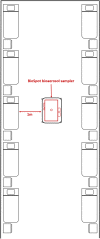Lack of viable severe acute respiratory coronavirus virus 2 (SARS-CoV-2) among PCR-positive air samples from hospital rooms and community isolation facilities
- PMID: 33487210
- PMCID: PMC7870907
- DOI: 10.1017/ice.2021.8
Lack of viable severe acute respiratory coronavirus virus 2 (SARS-CoV-2) among PCR-positive air samples from hospital rooms and community isolation facilities
Abstract
Background: Understanding the extent of aerosol-based transmission of severe acute respiratory syndrome coronavirus 2 (SARS-CoV-2) is important for tailoring interventions for control of the coronavirus disease 2019 (COVID-19) pandemic. Multiple studies have reported the detection of SARS-CoV-2 nucleic acid in air samples, but only one study has successfully recovered viable virus, although it is limited by its small sample size.
Objective: We aimed to determine the extent of shedding of viable SARS-CoV-2 in respiratory aerosols from COVID-19 patients.
Methods: In this observational air sampling study, air samples from airborne-infection isolation rooms (AIIRs) and a community isolation facility (CIF) housing COVID-19 patients were collected using a water vapor condensation method into liquid collection media. Samples were tested for presence of SARS-CoV-2 nucleic acid using quantitative real-time polymerase chain reaction (qRT-PCR), and qRT-PCR-positive samples were tested for viability using viral culture.
Results: Samples from 6 (50%) of the 12 sampling cycles in hospital rooms were positive for SARS-CoV-2 RNA, including aerosols ranging from <1 µm to >4 µm in diameter. Of 9 samples from the CIF, 1 was positive via qRT-PCR. Viral RNA concentrations ranged from 179 to 2,738 ORF1ab gene copies per cubic meter of air. Virus cultures were negative after 4 blind passages.
Conclusion: Although SARS-CoV-2 is readily captured in aerosols, virus culture remains challenging despite optimized sampling methodologies to preserve virus viability. Further studies on aerosol-based transmission and control of SARS-CoV-2 are needed.
Keywords: COVID-19; SARS-CoV-2; aerosols; air sampling; airborne; viral culture.
Figures
Similar articles
-
Air and environmental sampling for SARS-CoV-2 around hospitalized patients with coronavirus disease 2019 (COVID-19).Infect Control Hosp Epidemiol. 2020 Nov;41(11):1258-1265. doi: 10.1017/ice.2020.282. Epub 2020 Jun 8. Infect Control Hosp Epidemiol. 2020. PMID: 32507114 Free PMC article.
-
Bioaerosol Sampling for Severe Acute Respiratory Syndrome Coronavirus 2 (SARS-CoV-2) in a Referral Center with Critically Ill Coronavirus Disease 2019 (COVID-19) Patients March-May 2020.Clin Infect Dis. 2021 Oct 5;73(7):e1790-e1794. doi: 10.1093/cid/ciaa1880. Clin Infect Dis. 2021. PMID: 33506256 Free PMC article.
-
Viable SARS-CoV-2 in the air of a hospital room with COVID-19 patients.Int J Infect Dis. 2020 Nov;100:476-482. doi: 10.1016/j.ijid.2020.09.025. Epub 2020 Sep 16. Int J Infect Dis. 2020. PMID: 32949774 Free PMC article.
-
Assessment of Air Contamination by SARS-CoV-2 in Hospital Settings.JAMA Netw Open. 2020 Dec 1;3(12):e2033232. doi: 10.1001/jamanetworkopen.2020.33232. JAMA Netw Open. 2020. PMID: 33355679 Free PMC article.
-
Airborne transmission of SARS-CoV-2 via aerosols.Rev Med Virol. 2021 May;31(3):e2184. doi: 10.1002/rmv.2184. Epub 2020 Oct 26. Rev Med Virol. 2021. PMID: 33105071 Free PMC article.
Cited by
-
Revisiting SARS-CoV-2 environmental contamination by patients with COVID-19: The Omicron variant does not differ from previous strains.Int J Infect Dis. 2022 May;118:211-213. doi: 10.1016/j.ijid.2022.03.001. Epub 2022 Mar 5. Int J Infect Dis. 2022. PMID: 35257907 Free PMC article.
-
Multiple relationships between aerosol and COVID-19: A framework for global studies.Gondwana Res. 2021 May;93:243-251. doi: 10.1016/j.gr.2021.02.002. Epub 2021 Feb 9. Gondwana Res. 2021. PMID: 33584115 Free PMC article.
-
Air Change Rate and SARS-CoV-2 Exposure in Hospitals and Residences: A Meta-Analysis.Aerosol Sci Technol. 2024;58(3):217-243. doi: 10.1080/02786826.2024.2312178. Epub 2024 Feb 16. Aerosol Sci Technol. 2024. PMID: 38764553 Free PMC article.
-
A Detection Method for Crop Fungal Spores Based on Microfluidic Separation Enrichment and AC Impedance Characteristics.J Fungi (Basel). 2022 Nov 5;8(11):1168. doi: 10.3390/jof8111168. J Fungi (Basel). 2022. PMID: 36354935 Free PMC article.
-
Sampling for SARS-CoV-2 Aerosols in Hospital Patient Rooms.Viruses. 2021 Nov 23;13(12):2347. doi: 10.3390/v13122347. Viruses. 2021. PMID: 34960615 Free PMC article.
References
Publication types
MeSH terms
Substances
LinkOut - more resources
Full Text Sources
Other Literature Sources
Medical
Miscellaneous



